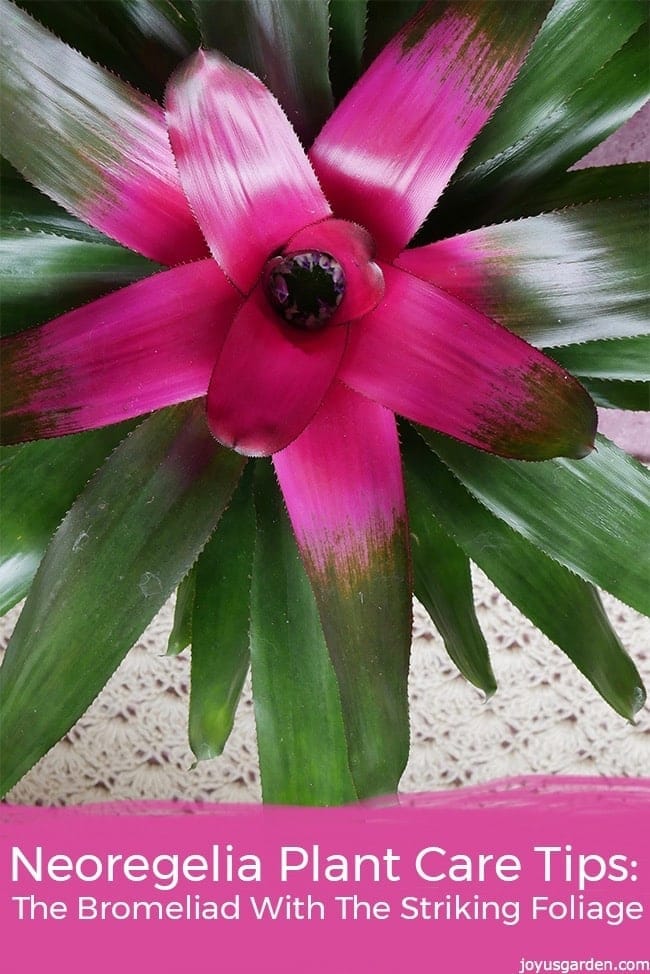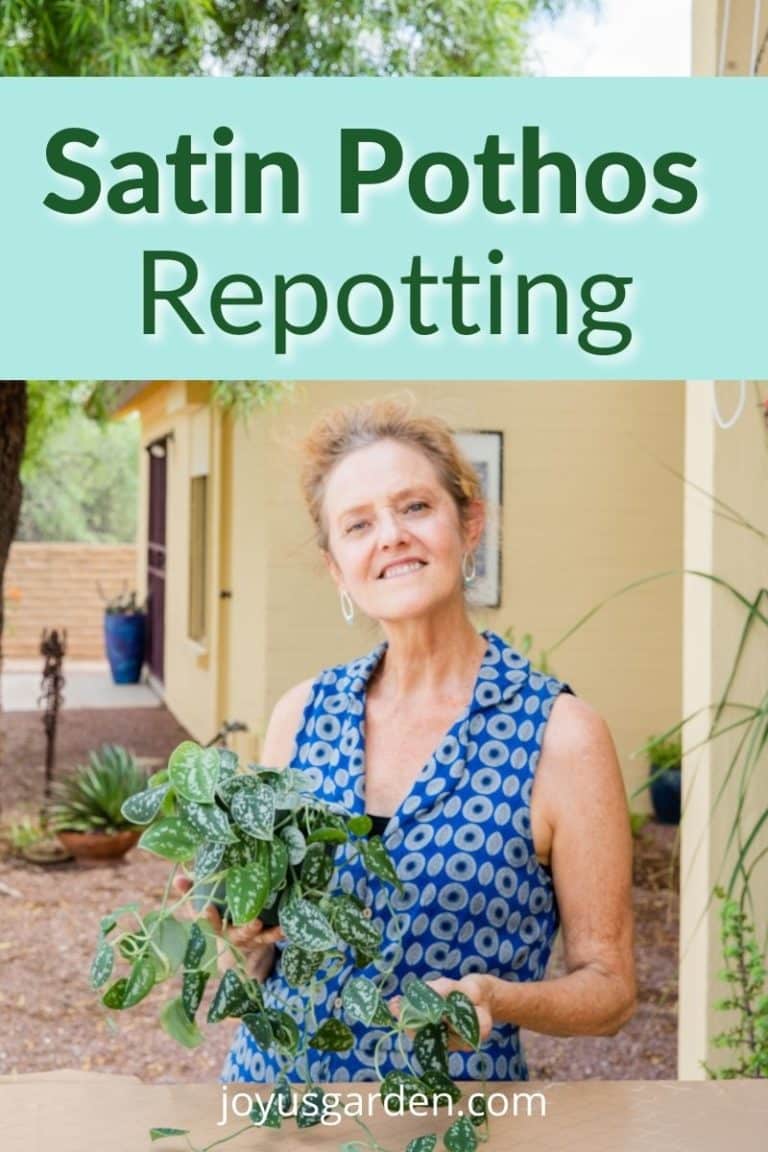Philodendron Birkin Care & Growing Guide
Do you want a gorgeous yet low-maintenance addition to your houseplant collection? You’ve found it. This plant has quickly become a favorite among indoor gardeners with its stunning, distinctive variegated leaves and easy-care nature. This details Philodendron Birkin care and what you need to know to keep it thriving.
I’ve read that it’s a hybrid, a cultivar, and a mutation. Who knows, but this one didn’t originate in the wild. The history of this beautiful houseplant has a few theories, but it’s obviously named after Jane Birkin and the Birkin handbag. Anyway, it’s a heck of a lot cheaper than the Hermes bag!
Philodendron Birkin Plant Traits
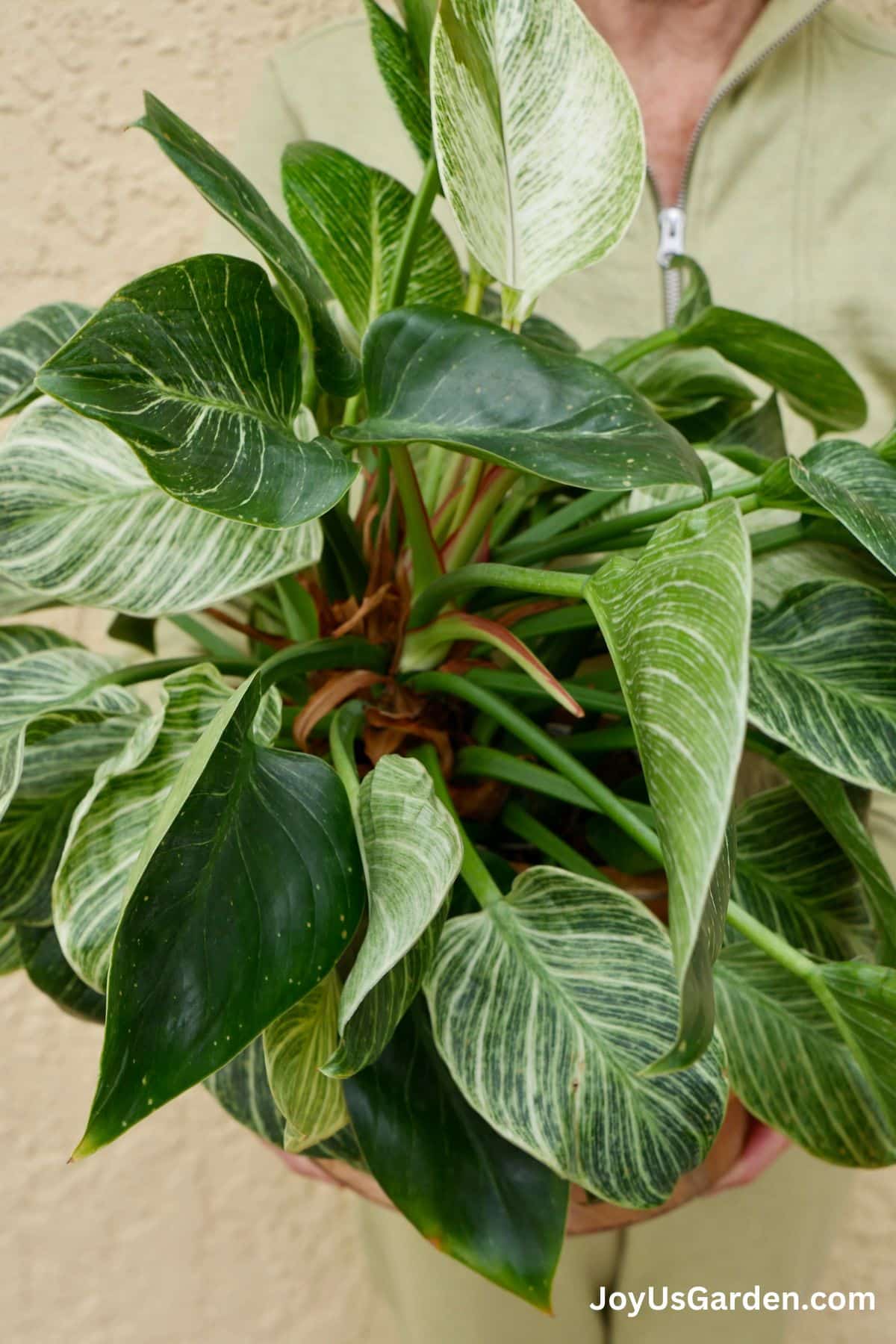
Size
This isn’t a climbing philodendron, it’s self supporting and won’t need a moss pole or trellis. Mine grows in a 6″ pot and is 20″ tall by 22″ wide. They ultimately reach 3′.
Uses
Right now, mine is a tabletop plant. It’ll eventually become a low, wide floor plant as it grows. Mature plants would look lovely in a plant stand. I have a Philodendron Congo in that plant stand, and it looks great!
Philodendron Birkine Growth Rate
Slow to moderate. Mine puts out a lot of new leaves, but it has a dense growth habit. It doesn’t grow rapidly like many philodendrons.
What Makes This Plant Unique
It’s obvious – the impressive foliage! Each heart-shaped leaf is unique. Some are beautiful white variegated leaves, some are dark green leaves, and the rest run the gamut in between.
It grows in a contained manner, holding its shape beautifully.
Philodendron Birkin Care and Growing Tips
Philodendron Birkin Light Requirements
It needs a medium to high light spot to keep the foliage vibrant. The ideal condition is moderate light or bright indirect sunlight. Mine sits on a coffee table 6′ away from a north-facing picture window and 17′ away from a trio of south-facing windows on the other side. I live in Arizona, and the sun shines a lot here!
High light is acceptable for a Birkin plant. Still, it’s essential to maintain a distance of at least 6-10′ from a west or south-facing window to prevent potential burning in direct, intense sunlight.
These plants grow even slower in low-light settings, leading to a leggy, sparse appearance and smaller leaves. You may even need to stake it. Like other plants, they’ll lose variegation in such conditions.
To ensure even exposure to light, it’s a good idea to rotate the plant occasionally if you observe the leaves leaning toward the light source. If the light diminishes significantly during the winter months, consider relocating the plant to a spot with more light. More on winter houseplant care here.
Philodendron Birkin Watering
I thoroughly water my Birkin when the soil almost dries (1/2 – 3/4 of the way).
Here in warm, sunny Tucson, AZ, I water mine every 6-7 days in the warmer months. It’s less often in the winter, maybe every 10-14 days.
Providing an exact watering schedule is challenging as the watering needs of Birkins depend on factors like the location it’s growing in, your home’s environment, the soil mix used, and the size of the pot.
Tap water can be damaging to houseplants over time. The damage starts as brown leaf tips and gets worse. Consider using distilled water if your tap water is high in salts or other minerals. I have a tankless r/o water filtration system in the kitchen with a cartridge that puts the good minerals back in.
Keeping the soil somewhat dry rather than consistently wet is best to prevent root rot. Make sure the pot has at least one drainage hole at the bottom, allowing excess water to drain freely.
Care should be taken to prevent too much water from building up in the saucer if one is placed beneath the pot. Here’s more info on watering indoor plants for you.
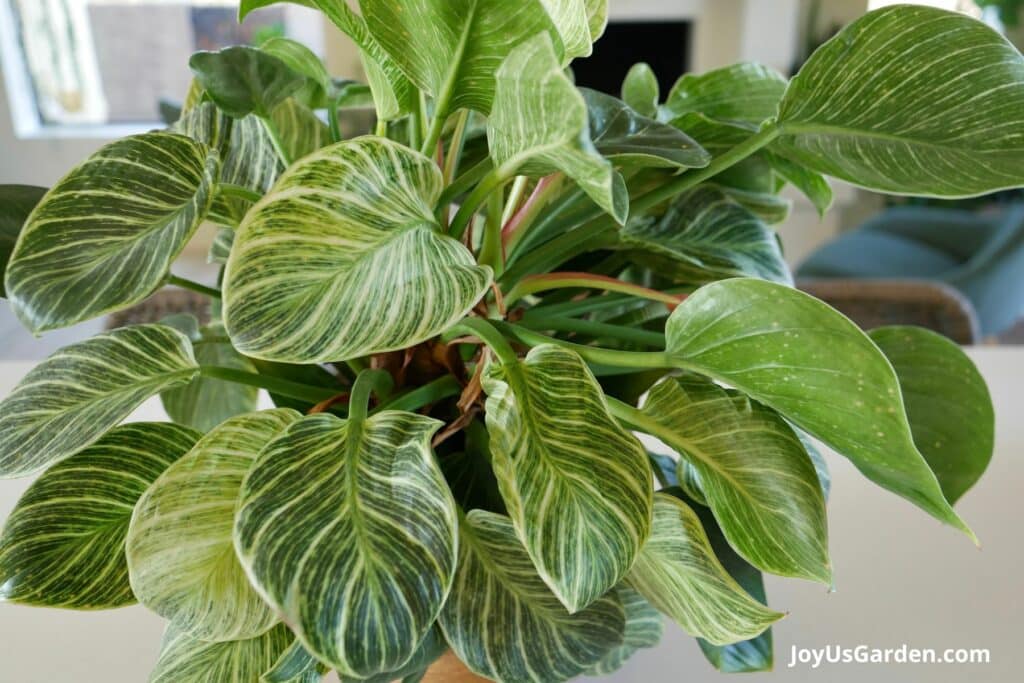
Temperature
Maintaining the right temperature for Philodendron Birkin care isn’t complicated. It prefers warm temperatures, but if your home is comfortable for you, it’ll be comfortable for your Birkin and other houseplants.
Be sure to keep yours away from drafty windows and doors, as well as air conditioning and heating vents.
Humidity
Like other tropical plants, this one prefers high humidity. That being said, I live in the desert, where the humidity levels are low, and mine is doing great. Small brown leaf tips will appear if there’s a lack of humidity. Mine has a few, but you must get close to see them.
I have a humidity meter in my dining room. I run my Canopy humidifiers at night when the humidity reads low, often here in Arizona! Any small humidifier placed nearby should help.
Your Birkin Philodendron will appreciate a misting two or three times a week.
Fertilizing/Feeding
The optimal time for fertilizing your plants is during spring and summer. You can extend fertilization into early fall if you live in a temperate climate like me.
We have a long growing season here in Tucson from mid-February through October. I fertilize with Maxsea or Sea Grow, Grow Big, and Liquid Kelp seven or eight times (once per month) during the growing season. It’s how I feed all my tropical plants. I choose two to use each season. I alternate using these granular and liquid fertilizers individually and don’t mix them.
Depending on your climate and growing zone, fertilizing two or three times a year might suffice for your indoor plants.
This plant appreciates the nutrients, but It’s crucial to avoid over-fertilizing, as too much fertilizer too often is more detrimental than beneficial.
Philodendron Birkin Soil
For all of my philodendron plants, I always use a good quality potting mix formulated for houseplants: peat-based, well-nourished, aerated, and good drainage.
Here’s the blend: 1/2 potting soil and 1/2 coco coir (an environmentally friendly alternative to peat moss). I also throw in a few handfuls of coco chips, with compost and worm compost, to add nutrients.
These are the potting soils I alternate between using: Ocean Forest and Happy Frog. Both are high quality, formulated for houseplants, and have good stuff added in.
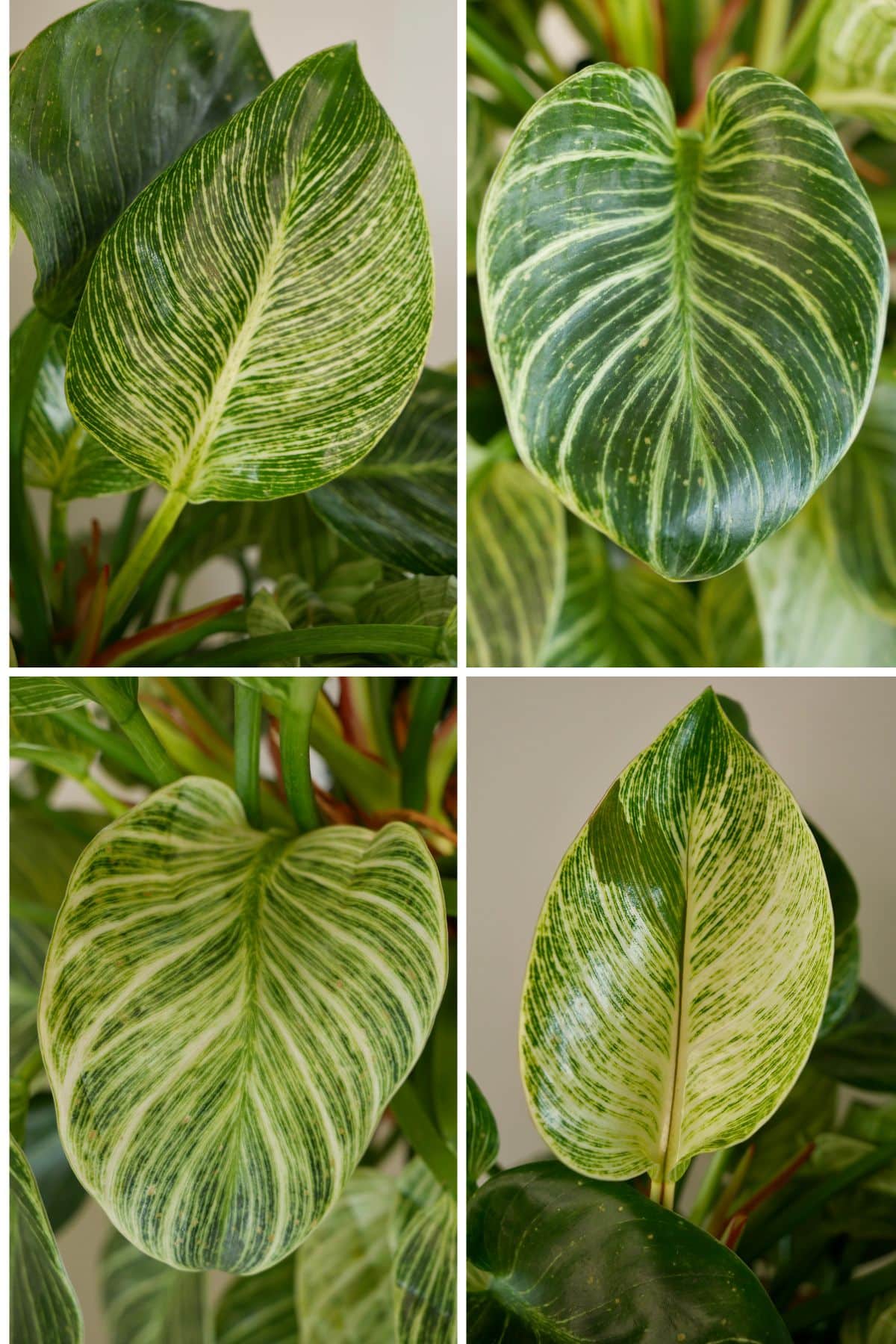
Repotting
This is also best done in spring, summer, and early fall. If you need to repot in winter, no worries. Just know that it’s not the optimum time.
Here are a few reasons for repotting: the roots are coming out of the drain holes, or the plant is too tight in its pot and has difficulty taking up water and receiving enough oxygen to the roots. In addition, the soil can get old, lose nourishment, and need a fresh mix. Over time, the plant can grow out of proportion with the pot.
As for pot size, go up one. For instance, from a 6″ pot to an 8″ pot.
Mine is in a 6″ grow pot with many drain holes on the bottom; no roots are showing. It’s looking good, so I won’t repot it for at least a year.
Pruning
This beautiful plant is a good choice if you’re not fond of pruning. In the year and a half I’ve had this plant, I haven’t had to prune it even once. I have seventy-plus houseplants, so I greatly appreciate this!
Propagating Philodendron Birkin
I’ve propagated hundreds of plants, but never a Philodendron Birkin, so I have nothing to share on this subject.
I’ve heard they can be propagated via stem cuttings. I imagine dividing this plant might be tricky because it grows so densely.
Pests
Plants and pests go hand in hand, but a healthy one is less susceptible, so it’s best to keep yours strong.
I have seven philodendrons, and only one of them (my Prince Of Orange) has gotten mealybugs. Keep your eyes out for spider mites, mealybugs, and aphids and scale.
Neem oil or insecticidal soap is effective for managing most pest infestations. I’ve been using insecticidal soap for two years, and it’s proven to be quite effective.
Given that pests often travel from one houseplant to another, taking swift action and treating upon detecting plant pests is crucial.
Toxic For Pets
Philodendron plants are considered to be toxic to pets. I consult the ASPCA website for my info on this subject and see in what way the plant is toxic.
80% of the plants in my house are considered to be toxic. I have two kitties; one occasionally chomps on a Spider Plant (it’s non-toxic). The other one could care less about plants.
You know your pets. If they’re prone to chewing on plants, I recommend placing your philodendron up high, making it difficult for them to reach.
Common Issues
One of the common problems with a Birkin Philodendron is yellow leaves. This is commonly caused by watering too often. If the stems are mushy, that’s due to wet soil.
One or two now and then is fine; it’s part of the growth process. Other causes of yellow leaves include too much fertilizer, low humidity levels, too little water, too much sun, and not enough light.
If your plant has a lot of deep green leaves, it’s not getting enough light. It needs bright light to bring out that delightful variegation.
Philodendron Birkin Care Video Guide
In conclusion, Remember to keep it in bright, indirect light, provide consistent watering without overdoing it, and occasionally mist its leaves to maintain the desired humidity level. With just a little attention and love, your Philodendron Birkin will reward you with beautiful leaves.
Philodendron Birkin care doesn’t have to be an intimidating task. By following these simple guidelines and providing the right conditions, you can ensure that your plant thrives and brings a touch of tropical beauty into your home.
Happy Gardening,


